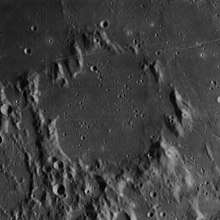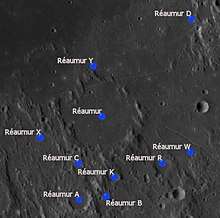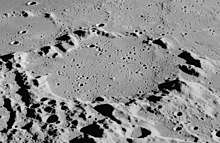Réaumur (crater)
Réaumur is the remains of a lunar impact crater located on the southern edge of Sinus Medii. Its diameter is 51 km. It was named after the 18th century French scientist René de Réaumur.[1] It shares an eroded rim with the similar crater Oppolzer to the northwest. It lies to the northwest of the large walled plain Hipparchus, and east of Flammarion. To the south is Gyldén, and farther to the south-southwest is Ptolemaeus.
 Lunar Orbiter 4 image | |
| Coordinates | 2.4°S 0.7°E |
|---|---|
| Diameter | 51 km |
| Depth | 1.3 km |
| Colongitude | 0° at sunrise |
| Eponym | René de Réaumur |
The rim of Réaumur is heavily eroded, and the northern half consists of little more than a series of low ridges in the mare. The southern rim is notched and indented by small crater impacts. The interior floor is relatively smooth and flat with no significant features.
The broken northern rim intersects a rille designated Rima Oppolzer. This feature is about 110 kilometers long and follows a course from the north-northeast to the south-southwest. To the east of the crater rim is a smaller rille designated Rima Réaumur. Farther to the east is the small Seeliger.
Satellite craters

By convention these features are identified on lunar maps by placing the letter on the side of the crater midpoint that is closest to Réaumur.


| Réaumur | Latitude | Longitude | Diameter |
|---|---|---|---|
| A | 4.3° S | 0.2° E | 16 km |
| B | 4.2° S | 0.9° E | 5 km |
| C | 3.4° S | 0.2° E | 5 km |
| D | 0.2° S | 2.8° E | 4 km |
| K | 3.8° S | 1.0° E | 7 km |
| R | 3.5° S | 2.1° E | 14 km |
| W | 3.2° S | 2.8° E | 3 km |
| X | 2.9° S | 0.6° W | 5 km |
| Y | 1.3° S | 0.6° E | 3 km |
References
- "Réaumur (crater)". Gazetteer of Planetary Nomenclature. USGS Astrogeology Research Program.
- Andersson, L. E.; Whitaker, E. A. (1982). NASA Catalogue of Lunar Nomenclature. NASA RP-1097.CS1 maint: ref=harv (link)
- Bussey, B.; Spudis, P. (2004). The Clementine Atlas of the Moon. New York: Cambridge University Press. ISBN 978-0-521-81528-4.CS1 maint: ref=harv (link)
- Cocks, Elijah E.; Cocks, Josiah C. (1995). Who's Who on the Moon: A Biographical Dictionary of Lunar Nomenclature. Tudor Publishers. ISBN 978-0-936389-27-1.CS1 maint: ref=harv (link)
- McDowell, Jonathan (July 15, 2007). "Lunar Nomenclature". Jonathan's Space Report. Retrieved 2007-10-24.CS1 maint: ref=harv (link)
- Menzel, D. H.; Minnaert, M.; Levin, B.; Dollfus, A.; Bell, B. (1971). "Report on Lunar Nomenclature by the Working Group of Commission 17 of the IAU". Space Science Reviews. 12 (2): 136–186. Bibcode:1971SSRv...12..136M. doi:10.1007/BF00171763.CS1 maint: ref=harv (link)
- Moore, Patrick (2001). On the Moon. Sterling Publishing Co. ISBN 978-0-304-35469-6.CS1 maint: ref=harv (link)
- Price, Fred W. (1988). The Moon Observer's Handbook. Cambridge University Press. ISBN 978-0-521-33500-3.CS1 maint: ref=harv (link)
- Rükl, Antonín (1990). Atlas of the Moon. Kalmbach Books. ISBN 978-0-913135-17-4.CS1 maint: ref=harv (link)
- Webb, Rev. T. W. (1962). Celestial Objects for Common Telescopes (6th revised ed.). Dover. ISBN 978-0-486-20917-3.CS1 maint: ref=harv (link)
- Whitaker, Ewen A. (1999). Mapping and Naming the Moon. Cambridge University Press. ISBN 978-0-521-62248-6.CS1 maint: ref=harv (link)
- Wlasuk, Peter T. (2000). Observing the Moon. Springer. ISBN 978-1-85233-193-1.CS1 maint: ref=harv (link)